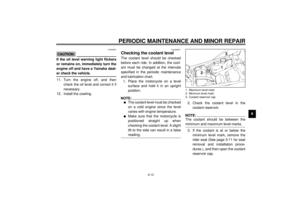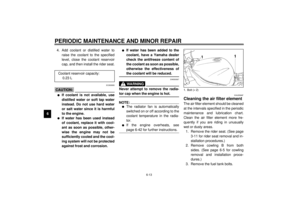Page 57 of 108

PERIODIC MAINTENANCE AND MINOR REPAIR
6-12
6
EC000067
CAUTION:_ If the oil level warning light flickers
or remains on, immediately turn the
engine off and have a Yamaha deal-
er check the vehicle. _11. Turn the engine off, and then
check the oil level and correct it if
necessary.
12. Install the cowling.
EAU03947*
Checking the coolant levelThe coolant level should be checked
before each ride. In addition, the cool-
ant must be changed at the intervals
specified in the periodic maintenance
and lubrication chart.
1. Place the motorcycle on a level
surface and hold it in an upright
position.NOTE:_ l
The coolant level must be checked
on a cold engine since the level
varies with engine temperature.
l
Make sure that the motorcycle is
positioned straight up when
checking the coolant level. A slight
tilt to the side can result in a false
reading.
_
2. Check the coolant level in the
coolant reservoir.NOTE:_ The coolant should be between the
minimum and maximum level marks. _3. If the coolant is at or below the
minimum level mark, remove the
rider seat (See page 3-11 for seat
removal and installation proce-
dures.), and then open the coolant
reservoir cap.1. Maximum level mark
2. Minimum level mark
3. Coolant reservoir cap
E_4sv.book Page 12 Friday, November 10, 2000 3:03 PM
Page 58 of 108

PERIODIC MAINTENANCE AND MINOR REPAIR
6-13
64. Add coolant or distilled water to
raise the coolant to the specified
level, close the coolant reservoir
cap, and then install the rider seat.
EC000080
CAUTION:_ l
If coolant is not available, use
distilled water or soft tap water
instead. Do not use hard water
or salt water since it is harmful
to the engine.
l
If water has been used instead
of coolant, replace it with cool-
ant as soon as possible, other-
wise the engine may not be
sufficiently cooled and the cool-
ing system will not be protected
against frost and corrosion.
l
If water has been added to the
coolant, have a Yamaha dealer
check the antifreeze content of
the coolant as soon as possible,
otherwise the effectiveness of
the coolant will be reduced.
_
EW000067
WARNING
_ Never attempt to remove the radia-
tor cap when the engine is hot. _NOTE:_ l
The radiator fan is automatically
switched on or off according to the
coolant temperature in the radia-
tor.
l
If the engine overheats, see
page 6-42 for further instructions.
_
EAU03948*
Cleaning the air filter element The air filter element should be cleaned
at the intervals specified in the periodic
maintenance and lubrication chart.
Clean the air filter element more fre-
quently if you are riding in unusually
wet or dusty areas.
1. Remove the rider seat. (See page
3-11 for rider seat removal and in-
stallation procedures.)
2. Remove cowling B from both
sides. (See page 6-5 for cowling
removal and installation proce-
dures.)
3. Remove the fuel tank bolts. Coolant reservoir capacity:
0.23 L1. Bolt (´ 2)
E_4sv.book Page 13 Friday, November 10, 2000 3:03 PM
Page 59 of 108
PERIODIC MAINTENANCE AND MINOR REPAIR
6-14
6 4. Lift the fuel tank to position it away
from the air filter case. (Do not dis-
connect the fuel hoses!)
EW000071
WARNING
_ l
Make sure that the fuel tank is
well supported.
l
Do not tilt or pull the fuel tank
too much, otherwise the fuel
hoses may come loose, which
could cause fuel leakage.
_
5. Remove the air filter case cover by
removing the screw.6. Pull the air filter element out.1. Screw
2. Air filter case cover
1. Air filter element
E_4sv.book Page 14 Friday, November 10, 2000 3:03 PM
Page 60 of 108

PERIODIC MAINTENANCE AND MINOR REPAIR
6-15
67. Lightly tap the air filter element to
remove most of the dust and dirt,
and then blow the remaining dirt
out with compressed air as shown.
If the air filter element is damaged,
replace it.
8. Insert the air filter element into the
air filter case.
EC000082*
CAUTION:_ l
Make sure that the air filter ele-
ment is properly seated in the
air filter case.
l
The engine should never be op-
erated without the air filter ele-
ment installed, otherwise the
pistons and/or cylinders may
become excessively worn.
_9. Install the air filter case cover by
installing the screw.
10. Install the fuel tank by installing the
bolts.
EW000072
WARNING
_ l
Before installing the fuel tank,
make sure that the fuel hoses
are not damaged. If any fuel
hose is damaged, do not start
the engine but have a Yamaha
dealer replace the hose, other-
wise fuel may leak.
l
Make sure that the fuel hoses
are properly connected and
routed, and not pinched.
_11. Install the cowlings, and then in-
stall the rider seat.
E_4sv.book Page 15 Friday, November 10, 2000 3:03 PM
Page 61 of 108

PERIODIC MAINTENANCE AND MINOR REPAIR
6-16
6
EAU00630
Adjusting the carburetors The carburetors are important parts of
the engine and require very sophisti-
cated adjustment. Therefore, most car-
buretor adjustments should be left to a
Yamaha dealer, who has the neces-
sary professional knowledge and expe-
rience. The adjustment described in
the following section, however, may be
serviced by the owner as part of routine
maintenance.
EC000095
CAUTION:_ The carburetors have been set and
extensively tested at the Yamaha
factory. Changing these settings
without sufficient technical knowl-
edge may result in poor perfor-
mance of or damage to the engine. _
EAU00632
Adjusting the engine idling
speed The engine idling speed must be
checked and, if necessary, adjusted as
follows at the intervals specified in the
periodic maintenance and lubrication
chart.
1. Start the engine and warm it up
for several minutes at 1,000–
2,000 r/min while occasionally
revving it to 4,000–5,000 r/min.NOTE:_ The engine is warm when it quickly re-
sponds to the throttle. _
2. Check the engine idling speed and,
if necessary, adjust it to specification
by turning the throttle stop screw. To
increase the engine idling speed,
turn the screw in direction
a. To de-
crease the engine idling speed, turn
the screw in direction
b.NOTE:_ If the specified idling speed cannot be
obtained as described above, have a
Yamaha dealer make the adjustment. _ 1. Throttle stop screwEngine idling speed:
1,000–1,100 r/min (for CH, A)
1,050–1,150 r/min (except for
CH, A)
E_4sv.book Page 16 Friday, November 10, 2000 3:03 PM
Page 62 of 108

PERIODIC MAINTENANCE AND MINOR REPAIR
6-17
6
EAU00635
Adjusting the throttle cable
free play The throttle cable free play should
measure 3–7 mm at the throttle grip.
Periodically check the throttle cable
free play and, if necessary, have a
Yamaha dealer adjust it.
EAU00637
Adjusting the valve clearance The valve clearance changes with use,
resulting in improper air-fuel mixture
and/or engine noise. To prevent this
from occurring, the valve clearance
must be adjusted by a Yamaha dealer
at the intervals specified in the periodic
maintenance and lubrication chart.
EAU00658
Tires To maximize the performance, durabil-
ity, and safe operation of your motor-
cycle, note the following points
regarding the specified tires.
Tire air pressure
The tire air pressure should be
checked and, if necessary, adjusted
before each ride.
EW000082
WARNING
_ l
The tire air pressure must be
checked and adjusted on cold
tires (i.e., when the temperature
of the tires equals the ambient
temperature).
l
The tire air pressure must be
adjusted in accordance with the
riding speed and with the total
weight of rider, passenger, car-
go, and accessories approved
for this model.
_
a. Throttle cable free playE_4sv.book Page 17 Friday, November 10, 2000 3:03 PM
Page 63 of 108

PERIODIC MAINTENANCE AND MINOR REPAIR
6-18
6
CE-01E
CE-07EEWA00012
WARNING
_ Because loading has an enormous
impact on the handling, braking,
performance and safety characteris-
tics of your motorcycle, you should
keep the following precautions in
mind. l
NEVER OVERLOAD THE
MOTORCYCLE! Operation of an
overloaded motorcycle may re-
sult in tire damage, loss of con-
trol, or severe injury. Make sure
that the total weight of rider, pas-
senger, cargo, and accessories
does not exceed the specified
maximum load for the vehicle.
l
Do not carry along loosely
packed items, which can shift
during a ride.
l
Securely pack the heaviest
items close to the center of the
motorcycle and distribute the
weight evenly on both sides.
l
Adjust the suspension and tire
air pressure with regard to the
load.
l
Check the tire condition and air
pressure before each ride.
_
Tire air pressure
(measured on cold tires)
Load* Front Rear
Up to 90 kg250 kPa
(2.50 kg/cm
2,
2.50 bar)250 kPa
(2.50 kg/cm
2,
2.50 bar)
90 kg–maximum290 kPa
(2.90 kg/cm
2,
2.90 bar)290 kPa
(2.90 kg/cm
2,
2.90 bar)
High-speed riding290 kPa
(2.90 kg/cm
2,
2.90 bar)290 kPa
(2.90 kg/cm
2,
2.90 bar)
Maximum load* 196 kg
* Total weight of rider, passenger, cargo and
accessories
E_4sv.book Page 18 Friday, November 10, 2000 3:03 PM
Page 64 of 108

PERIODIC MAINTENANCE AND MINOR REPAIR
6-19
6Tire inspection
The tires must be checked before each
ride. If the center tread depth reaches
the specified limit, if the tire has a nail
or glass fragments in it, or if the side-
wall is cracked, have a Yamaha dealer
replace the tire immediately.
CE-08ENOTE:_ The tire tread depth limits may differ
from country to country. Always comply
with the local regulations. _
EW000079
WARNING
_ l
Have a Yamaha dealer replace
excessively worn tires. Besides
being illegal, operating the
motorcycle with excessively
worn tires decreases riding sta-
bility and can lead to loss of
control.
l
The replacement of all wheel-
and brake-related parts, includ-
ing the tires, should be left to a
Yamaha dealer, who has the
necessary professional knowl-
edge and experience.
_
Tire information
This motorcycle is equipped with cast
wheels and tubeless tires with valves.
1. Tire sidewall
a. Tire tread depthMinimum tire tread depth
(front and rear)1.6 mm
1. Tire air valve
2. Tire air valve core
3. Tire air valve cap with seal
E_4sv.book Page 19 Friday, November 10, 2000 3:03 PM
 1
1 2
2 3
3 4
4 5
5 6
6 7
7 8
8 9
9 10
10 11
11 12
12 13
13 14
14 15
15 16
16 17
17 18
18 19
19 20
20 21
21 22
22 23
23 24
24 25
25 26
26 27
27 28
28 29
29 30
30 31
31 32
32 33
33 34
34 35
35 36
36 37
37 38
38 39
39 40
40 41
41 42
42 43
43 44
44 45
45 46
46 47
47 48
48 49
49 50
50 51
51 52
52 53
53 54
54 55
55 56
56 57
57 58
58 59
59 60
60 61
61 62
62 63
63 64
64 65
65 66
66 67
67 68
68 69
69 70
70 71
71 72
72 73
73 74
74 75
75 76
76 77
77 78
78 79
79 80
80 81
81 82
82 83
83 84
84 85
85 86
86 87
87 88
88 89
89 90
90 91
91 92
92 93
93 94
94 95
95 96
96 97
97 98
98 99
99 100
100 101
101 102
102 103
103 104
104 105
105 106
106 107
107






